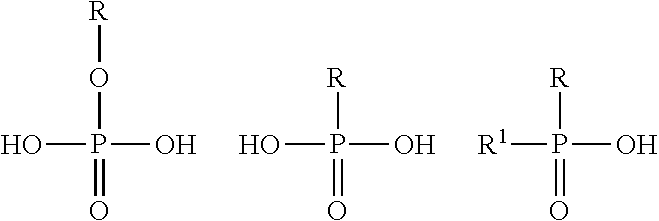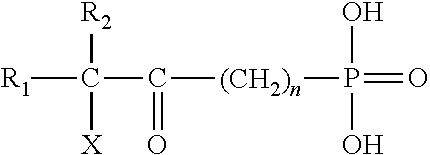Fluorocarbon polymer coatings prepared by living polymerization
a fluorocarbon polymer and polymer technology, applied in coatings, nanotechnology, special surfaces, etc., can solve the problems of inherently contained errors and numerical values, and achieve the effect of minimal thickness and good adhesion
- Summary
- Abstract
- Description
- Claims
- Application Information
AI Technical Summary
Benefits of technology
Problems solved by technology
Method used
Image
Examples
examples
[0056]The following example shows the preparation of a coating prepared via ATRP of a fluorocarbon monomer on a SAM of an initiator-coated borosilicate glass substrate. All parts are by weight unless otherwise indicated.
[0057]The materials used in the Example were as follows:
[0058]Organometallic solution: 0.025% by weight of tantalum ethoxide in isopropanol and 0.0025% by weight anhydrous hydrochloric acid in isopropanol.
[0059]Organophosphorus acid: 1 micromolar solution of 11-(2-bromoisobutyrol) undecyl phosphonic acid in toluene.
[0060]Fluorocarbon monomer: CAPSTONE 62-MA (a mixture of C4-C8 perfluoroalkyl methacrylate monomers sold by DuPont®).
[0061]Catalyst: Copper (I) Bromide.
[0062]Ligand: N,N,N,N,N pentamethyldiethylene triamine (PMDETA).
[0063]Reducing agent: Tin (II) ethylhexanoate.
[0064]Borosilicate glass slides (2.5×7.5 cm) were cleaned by immersion in a heated solution (60-70° C.) of 1% Alconox powdered precision cleaner in distilled water, rinsed under running water then d...
PUM
| Property | Measurement | Unit |
|---|---|---|
| Structure | aaaaa | aaaaa |
| Polymeric | aaaaa | aaaaa |
Abstract
Description
Claims
Application Information
 Login to View More
Login to View More - R&D
- Intellectual Property
- Life Sciences
- Materials
- Tech Scout
- Unparalleled Data Quality
- Higher Quality Content
- 60% Fewer Hallucinations
Browse by: Latest US Patents, China's latest patents, Technical Efficacy Thesaurus, Application Domain, Technology Topic, Popular Technical Reports.
© 2025 PatSnap. All rights reserved.Legal|Privacy policy|Modern Slavery Act Transparency Statement|Sitemap|About US| Contact US: help@patsnap.com



